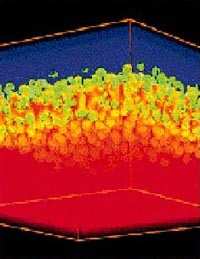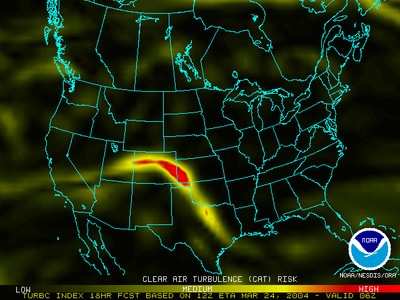NASA Tests Aviation Turbulence Detection System
 A NASA developed technology that can
automatically alert pilots of potentially dangerous turbulence will
make its first evaluation flights on a commercial airliner.
A NASA developed technology that can
automatically alert pilots of potentially dangerous turbulence will
make its first evaluation flights on a commercial airliner.
The idea behind NASA's Turbulence Prediction and Warning System
(TPAWS) airborne radar is to give flight crews enough advance
warning, so they can avoid turbulence or advise flight attendants
and passengers to sit down and buckle up to avoid injury.
Researchers at NASA's Langley Research Center (LaRC), Hampton
(VA) developed TPAWS to detect turbulence associated with
thunderstorms as part of the NASA Aviation Safety and Security
Program. NASA teamed with Delta Air Lines, Atlanta; AeroTech
Research, Hampton; and Rockwell Collins, Cedar Rapids (IA) for the
in-service evaluation of a production-prototype airborne radar unit
with turbulence hazard prediction capabilities.
Delta will install the TPAWS/Rockwell Collins radar unit on a
Boeing 737-800 this summer. Delta flight crews will use and
evaluate the technology during regularly scheduled flights in the
US and South America. The prototype is expected to fly for six to
nine months.
Researchers from NASA, the companies involved and the Federal
Aviation Administration (FAA) will evaluate interim and final
results of the turbulence prediction radar system. If the
evaluation is successful, the technology may be adopted for new and
existing aircraft.
"The TPAWS technology is an enhanced turbulence detection radar
system that detects atmospheric turbulence by measuring the motions
of the moisture in the air," said NASA's TPAWS project manager Jim
Watson. "It is a software signal processing upgrade to existing
predictive Doppler wind shear systems that are already on
airplanes," he added.
"Delta Air Lines is always interested in evaluating new
technologies that offer the potential for improved ride quality and
safety for our customers and flight crews," said Ira Pearl, Delta
flight operations technical support director.
Researchers have already tested TPAWS on a NASA Boeing 757
research aircraft. The TPAWS equipped plane searched for turbulence
activity around thunderstorms for eight weeks. The aircraft flew
within a safe distance of storms, so researchers could experience
the turbulence and compare the radar prediction to how the plane
responded to the encounters. After one severe patch of turbulence,
a NASA research pilot said his confidence in the enhanced radar had
"gone up dramatically," since the plane's weather radar did not
show anything, while the same time the TPAWS display showed rough
skies ahead.

Atmospheric turbulence encounters are the leading cause of
injuries to passengers and flight crews in non-fatal airline
accidents. FAA statistics show an average of 58 airline passengers
are annually injured in US turbulence incidents. Ninety eight
percent of those injuries happen, because people don't have their
seat belts fastened. Turbulence encounters are hazardous; they cost
airlines money and time, in the form of re-routing flights, late
arrivals, additional inspections and maintenance for aircraft.
The NASA Aviation Safety and Security Program is a partnership
with the FAA, aircraft manufacturers, airlines and the Department
of Homeland Security to reduce the fatal aircraft accident rate,
protect air travelers and the public from security threats.
Researchers at four NASA centers are working to develop advanced,
affordable technologies to make flying safer and more secure.
 ANN's Daily Aero-Linx (05.06.25)
ANN's Daily Aero-Linx (05.06.25) ANN's Daily Aero-Term (05.06.25): Ultrahigh Frequency (UHF)
ANN's Daily Aero-Term (05.06.25): Ultrahigh Frequency (UHF) ANN FAQ: Q&A 101
ANN FAQ: Q&A 101 Classic Aero-TV: Virtual Reality Painting--PPG Leverages Technology for Training
Classic Aero-TV: Virtual Reality Painting--PPG Leverages Technology for Training Airborne 05.02.25: Joby Crewed Milestone, Diamond Club, Canadian Pilot Insurance
Airborne 05.02.25: Joby Crewed Milestone, Diamond Club, Canadian Pilot Insurance




